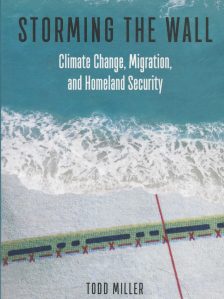
Click to enlarge.
The two agencies of the U.S. government that take climate change most seriously are the Pentagon and the Department of Homeland Security.
They foresee droughts, floods and storms on a scale that will create global political instability and millions of climate refugees, mainly from countries already ravaged by war and poverty. While other parts of the government dither and deny, they have spent billions since 2003 preparing for the coming emergency.
Their preparation, however, is not aimed at preventing or slowing down climate change, nor is it principally aimed at relieving distress. Rather it is in protecting the U.S. homeland and American business interests from the desperate masses.
 A journalist named Todd Miller did a good job of reporting on this in STORMING THE WALL: Climate Change, Migration and Homeland Security, published in 2017.
A journalist named Todd Miller did a good job of reporting on this in STORMING THE WALL: Climate Change, Migration and Homeland Security, published in 2017.
He attended a Defense, National Security and Climate Change conference in Washington, D.C., in 2015, attended by top military brass and government and corporate officials. A NASA representative told how the Space Shuttle and F-35 fighter required chrome, columbium and titanium, which are sourced from South Africa, Congo and Zambia, all threatened with political instability due to climate change.
“If these stressing factor result in increased migration,” he said, “it will just increase the potential for instability and conflict,” which would affect the U.S. ability to obtain elements “critical to the alloys we need to support the system.”
It was at that meeting that Miller for the first time heard the expression, “military-environmental-industrial complex.” Billions of dollars are being spent to, on the one hand, wean the U.S. military itself from dependence on fossil fuels and, on the other, maintain the political and economic status quo in the face of climate-driven upheaval.
He devoted several chapters of the book to migration from central America and Mexico into the southwest USA. He showed that the border is not a line on the map separating the United States from Mexico.
The border area extends 100 miles into the interior of the United States, where Immigration and Customs Enforcement (ICE) acts like a military occupying force. Miller noted that an order by President Obama against racial profiling specifically exempted the Department of Homeland Security.
It also extends down through Mexico into Central America, where there are a series of checkpoints, aided by U.S. military advisers and U.S. military equipment, designed to intercept migrants on their way. There are fewer arrests nowadays at the international border, but this may not mean that fewer people are trying to cross the border. It may just mean that more of them are intercepted before they get close.
The U.S. Coast Guard nowadays does more than guard the coasts. After the 2010 earthquake, the Coast Guard patrolled the coast of Haiti, turning back anyone who tried to flee, and even set up a detention center at Guantanamo Bay.
Migrants leave their home countries for many reasons—commonly poverty, war, tyranny or crime. But, in the words of a Marine Corps general, climate change is a “threat multiplier.” Events such as the 2015 drought in Guatemala, Honduras, El Salvador and Nicaragua make all the underlying social problems worse.
The United States is not unique. The new “smart border” between Turkey and Syria has a new tower every 1,000 feet, a three-language alarm system, and “automated firing zones” supported by hovering zeppelin drones, Miller wrote.
Experts say floods and a rising sea will cause millions to flee Bangladesh. India has a 2,000-mile ‘iron wall” on its border and soldiers with orders to shoot to kill. More than 1,000 Bangladeshis were killed between 2001 and 2011 while trying to cross the border.
(more…)















